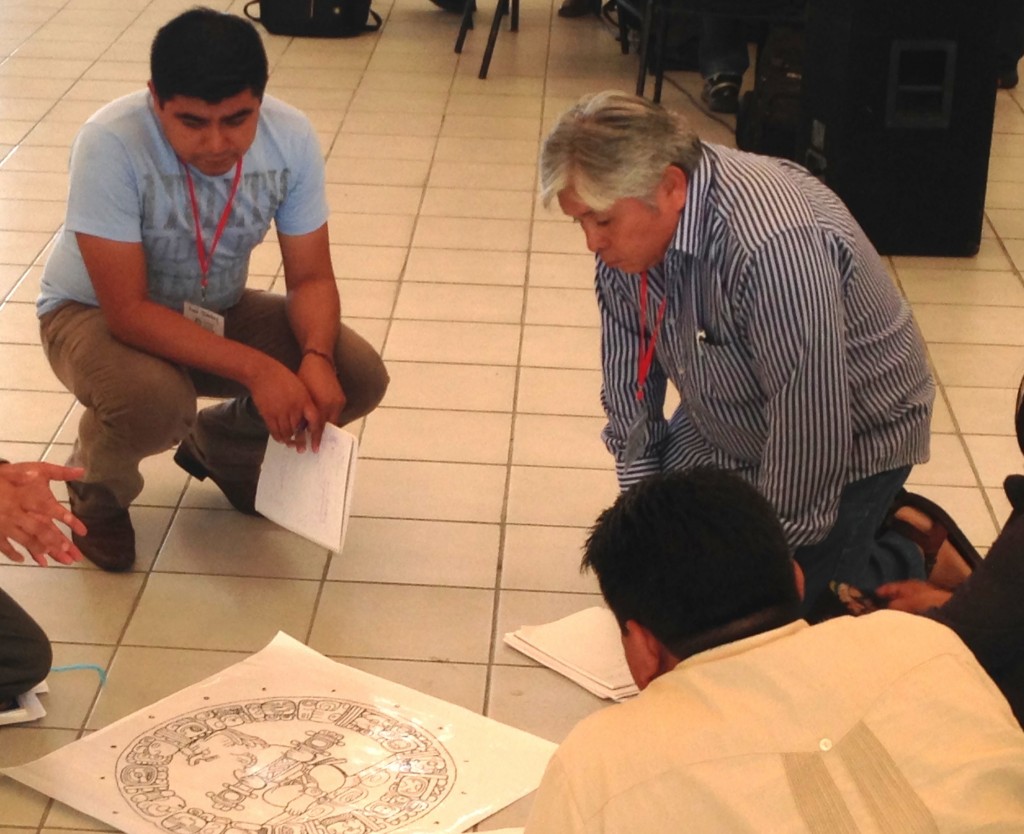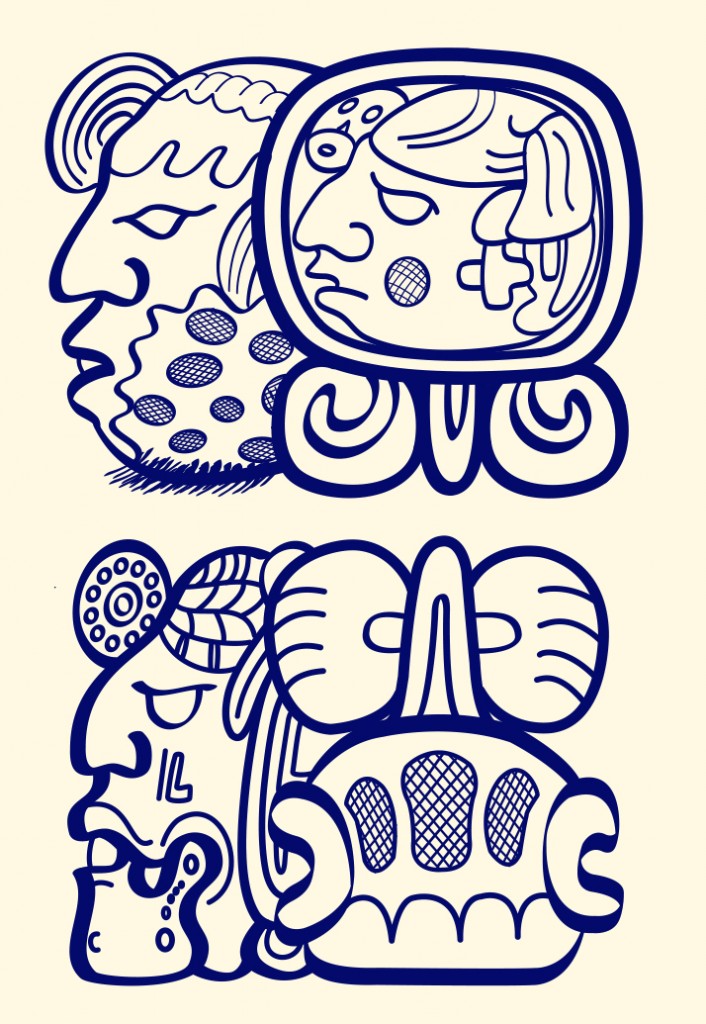First Course in Epigraphy, Maní, Yucatán
July 14-18, 2014
Given by Iván Jiménez, Daniela Cano Chan, and Atilano Ceballos (these three were participants at the Second International Congress of Maya Epigraphers in Ocosingo, Chiapas).

Iván Jiménez (on the left) and Atilano Ceballos participating in the Second International Congress of Maya Epigraphers in Ocosingo, Chiapas.
July 14 and 15
2 Oc and 3 Chuen
The course began with a prayer to Father-Mother God giving thanks for the day and for what was occurring.
Curso Inicial de Epigrafía, Maní, Yucatán
14 -18 de Julio del 2014
Impartido por Iván Jiménez, Daniela Cano Chan, y Atilano Ceballos (los tres fueron participantes al Segundo Congreso Internacional de Epigrafistas Mayas en Ocosingo, Chiapas.)

Iván Jiménez (a la izquierda) y Atilano Ceballos (facilitadores) participando en el Segundo Congreso Internacional de Epigrafistas Mayas en Ocosingo, Chiapas.
14 y 15 de Julio
2 Oc y 3 Chuen
Se inicia el curso con una oración a Papá-Mamá Dios agradeciendo por el día y por lo que se llevara a cabo.
After the prayer the course teachers handed out the package of course materials that would be used throughout the course, followed by an explanation for each of the materials, and how each one was to be used.
The workshop began with an “Introduction to writing in glyphs” and “Glyphs that are syllables (the syllabary)” given by Iván Jiménez. He gave a commentary and pointed out interesting facts about the material presented. This was followed with the theme “Glyphs that mean whole words (logograms)” and “How to write words with glyphs,” presented by Daniela Cano Chan. Then they analyzed the make-up of names and titles in order to say who is the father or the mother and where are they from. With this information, each student was given the exercise to create their own stela with the information just analyzed, in such a way that in the end they created a small stela of their own lineage.
July 16 and 17
4 Eb and 5 Ben
The course began by analyzing the stelae of the students and answering questions about the work just completed. Following that there was a presentation of Maya numbers, the Maya calendar known as the Tsolk’in and the analysis of each of the elements contained in the Maya calendar known as the Haab.
The instructors explained how to read a stela, and what is the I.S.I.G (Initial Series Introductory Glyph). This was followed by analyzing the spiritual way that our calendar was used by our Maya grandfathers and grandmothers. It was discussed what has been saved and what has been lost. It was also discussed the influence of the moon and the sun on the days of the calendar, the Wayeb, the make-up of the calendar cycles, and their use over time.
Stelae were viewed in order to analyze them and to find the glyphs that the students had become familiar with, so that viewing other texts later would be easier. Also vases and plates were shown with dedicatory phrases of who owned the objects.
July 18 (lead by Atilano Ceballos)
6 Ix
This day was initiated with a retrospective of what had been learned in the course, and then observing more stelae and a replica of a vase with glyphs. Afterward, we had the closing words and giving of diplomas by Maestro Miguel Medina Carrillo.
More workshops were planned for the coming months, and will be reported on future dates.
Después los facilitadores del curso se presentan y entregan el paquete de materiales que servirán a lo largo del curso. Enseguida se hace la presentación de cada material entregado, su forma de uso y el nombre de cada uno.
Se empieza el taller en forma con la “Introducción a la escritura en Glifos” y “Glifos que significan silabas (Silabario)” a cargo de Iván Jiménez. Se hacen comentarios y se puntualizan datos interesantes acerca de la información presentada. Se prosigue con el tema de: “Glifos que significan palabras completas (Logogramas)” y “Como escribir palabras con glifos”, a cargo de Daniela Cano Chan. Se analizan los logogramas y su significado y después se dan ejemplos sobre como se puede escribir inicialmente el nombre personal por medio de glifos. Después analizaron la composición de la conformación del nombre, los oficios, para decir quien es el padre y la madre y del lugar de donde provienen. Con esta información analizada y comentada se les deja de ejercicio que cada alumno empiece a realizar su propia estela con la información antes ya analizada, de manera que al final construyan una pequeña estela de su linaje.
16 y 17 de Julio del 2014
4 Eb y 5 Ben
Se inicia el curso analizando las estelas de los alumnos y contestando dudas acerca del trabajo realizado. En seguida se hace la presentación de los números Mayas, el calendario maya Tzol K´iin y el análisis de cada uno de los elementos que contiene y su relación el calendario Maya del Ha´ab.
Los facilitadores explicaron la estructura del como se lee una estela y lo que es el G.I.S.I (Glifo introductorio de la serie Inicial). Se sigue analizando la manera espiritual en la que el calendario maya era utilizado por nuestros abuelos y abuelas Mayas. Se platican cuales se conservan y cuales se han perdido. Se habla también de la influencia de la luna y del sol en los días del calendario, se habla del Uayeb y la composición de las ruedas calendáricas, su uso y su movimiento a través del tiempo.
Se proyectan algunas estelas, para analizar y se trata de encontrar glifos con los que ya se ha familiarizado cada alumno, para después ir viendo otros textos mas fáciles de descifrar, se proyectan también vasijas y platones con frases dedicatorias a quien perteneció el objeto.
18 de Julio del 2014 (dirigido por Atilano Ceballos)
6 Ix
Se inicia el taller haciendo una retroalimentación de lo aprendido en el curso, para después pasar a observar más estelas y una replica de una vasija con glifos. Después se procede a dar las palabras de despedida y la entrega de diplomas a cargo del Maestro Miguel Medina Carrillo.
Tres más talleres estan programados para fechas en el futuro. Reportaremos sobre estos en los meses que vienen.
Iván Jiménez,
Maní, Yucatán




